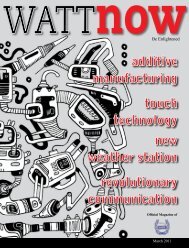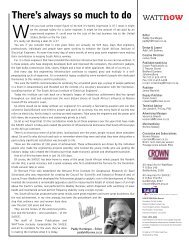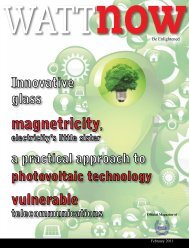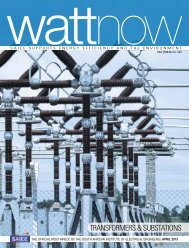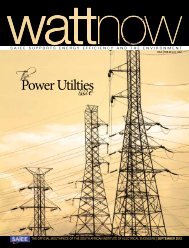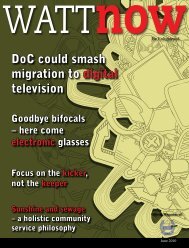Cut electricity consumption with automation - Watt Now Magazine
Cut electricity consumption with automation - Watt Now Magazine
Cut electricity consumption with automation - Watt Now Magazine
Create successful ePaper yourself
Turn your PDF publications into a flip-book with our unique Google optimized e-Paper software.
The key to smart grids is to use an Internet protocol that<br />
communicates <strong>with</strong> home devices and shuttles information back and<br />
forth between the utility and the customer.<br />
“With a smart, two-way communication mechanism operating<br />
between a power consumer and a provider, both parties can exercise<br />
far more control over the actual <strong>consumption</strong> of electrical power,”<br />
he says.<br />
The existing power lines would carry a combination of power and<br />
information to identify the exact status of the line in real time. Using<br />
digital communication the grid sensors gather information from every<br />
centimetre of the grid to establish how much power is flowing through<br />
the grid and how reliable that supply is.<br />
“Data can then be transmitted directly to household appliances<br />
which will respond by using power when the energy <strong>consumption</strong> – and<br />
the price – is lower. For instance an automatic washing machine could<br />
be switched on via the grid to start its cycle at say 02h30 and run for<br />
30 minutes at a time when power demand was low. The user would<br />
simply wake up in the morning and find the washing cycle complete,”<br />
he says.<br />
By using smart digital controls it is possible for the power provider<br />
to anticipate and respond to grid malfunctions because if a sensor<br />
finds that a power line is congested the controller will be able to reroute<br />
the power in real time before the grid malfunctions and a power<br />
failure occurs.<br />
Shahidehpour believes that an Advanced Meter Infrastructure<br />
(AMI) or smart meter should be installed at the customer’s premises to<br />
allow for continuous two-way communications that can be controlled<br />
and managed by software systems running on remote computers.<br />
The smart meter measures, monitors and helps to manage the<br />
actual energy used at the premises via two-way communication links<br />
that include cellular networks, satellite and radio frequency networks..<br />
this means, too, that <strong>electricity</strong> outages can be detected and restored<br />
rapidly by the power providers because the exact nature of the fault –<br />
and it’s precise location – can be identified immediately and rectified.<br />
Shahidehpour points out that a new technology, known as Zig Bee has<br />
been developed as a global wireless language that allows dramatically<br />
different devices to work together and communicate seamlessly.<br />
“ZigBee is a single standard used to set up communication <strong>with</strong><br />
devices on a home area network which links the power utility to<br />
the customer using a two-way open communicaiton network. This<br />
technology allows appliances to be controlled and monitored at all<br />
times in real time.<br />
“The technology was developed by the ZigBee Alliance, a worldwide<br />
working group that developed software application standard that<br />
would run on top of the wireless standards defined by the Institute of<br />
Electrical and Electronic Engineers,” he says.<br />
Already in the US the results of the ZigBee system are providing<br />
some astonishing results <strong>with</strong> one industrial manufacturing concern<br />
saving as much as 37 percent of their average monthly <strong>consumption</strong><br />
by using the smart metering systems and the ZigBee technology.<br />
In the US the markets for ZigBee include: building <strong>automation</strong>,<br />
industrial control systems, energy management, personal healthcare,<br />
telecommunicaitons services, home control and <strong>automation</strong>, consumer<br />
electronics and computers.<br />
As Shahidehpour points out not all appliances in a home need to<br />
be used concurrently. There’s no reason that a pool pump must run<br />
during the day and be switched off at night just as there’s no reason<br />
to keep a microwave in standby mode all the time.<br />
“Convenience is the key factor for appliances being left on or pool<br />
pumps operating during daylight hours,” says Shahidehpour. “If the<br />
pool pump came on by itself in the middle of the night when power<br />
<strong>consumption</strong> is low it would keep the pool water just as clean as it<br />
does when running during the day.”<br />
Referring to the affordability of the smart grid Shahidehpour says<br />
that grid modernisation costs are equivalent to one pizza per household<br />
per month spread over a period of between ten and 15 years.<br />
“If done correctly grid modernisation will be less expensive in the<br />
long run than replacement of damaged or poorly maintained grids.<br />
Smart grids will mean fewer blackouts and greatly reduced local<br />
interruptions <strong>with</strong> the concomitant savings from reduced congestion<br />
or needing to build expensive generation plants that work only at peak<br />
times,” he says.<br />
“Smart grid upgrades will allow <strong>electricity</strong> provides to ease<br />
congestion on power lines and send between 50 percent and 300<br />
percent more electicity through the existing corridors. In fact statistics<br />
compiled in the US indicate that smar grid technologies would reduce<br />
power disturbance costs to the US economy by $49-billion a year and<br />
would also reduce the need for infrastructure expansion investment by<br />
about $100-billion over the next 20 years.<br />
“By allowing users to control <strong>electricity</strong> expenditure the smart<br />
grid technology would add between $5- to $7-billion back into the<br />
US economy by 2015 and between $15- and $20-billion per year by<br />
2020.,” he adds.<br />
Given the fact that South Africa needs to spend about R25-billion<br />
on essential repairs and maintenance to the existing <strong>electricity</strong><br />
distribution infrastructure it seems that perhaps the authorities<br />
should carefully consider deploying smart grid technologies now in an<br />
effort to reduce wastage of <strong>electricity</strong> in South Africa.<br />
15




